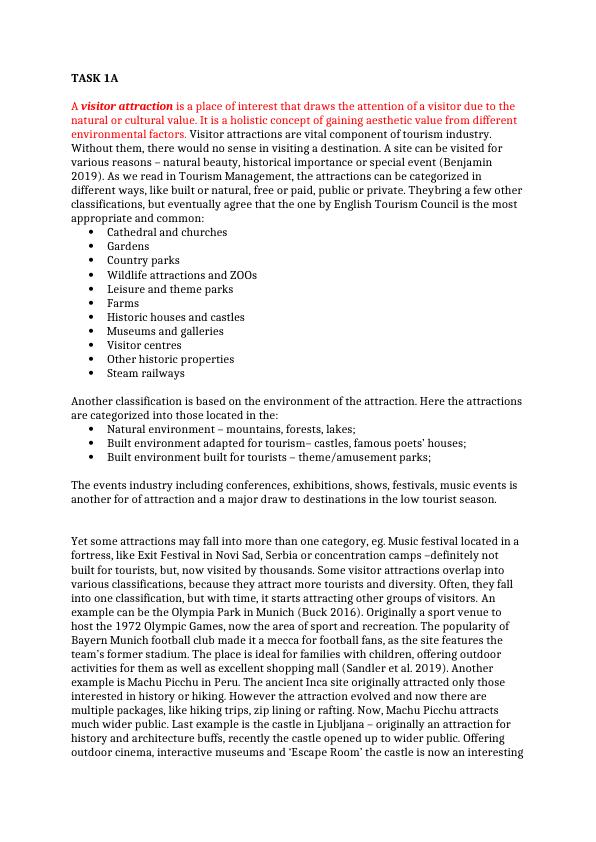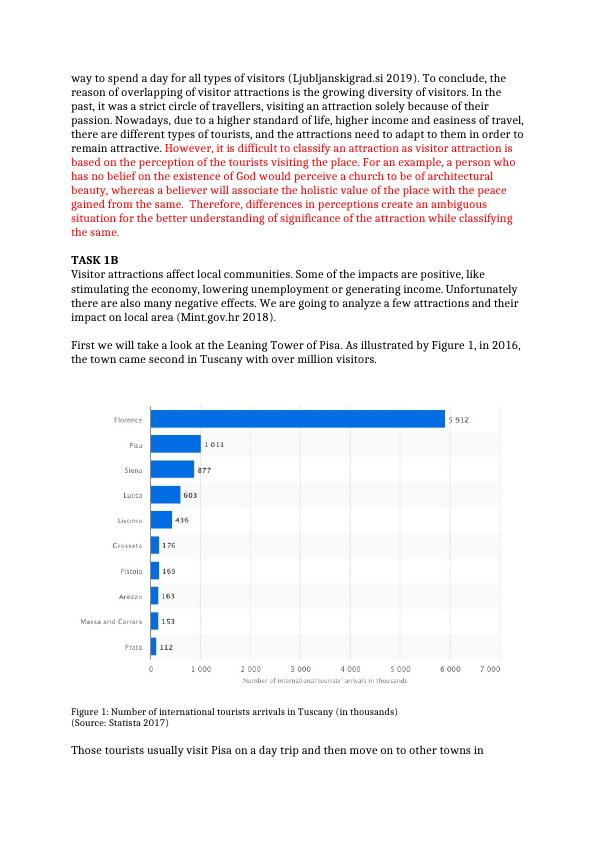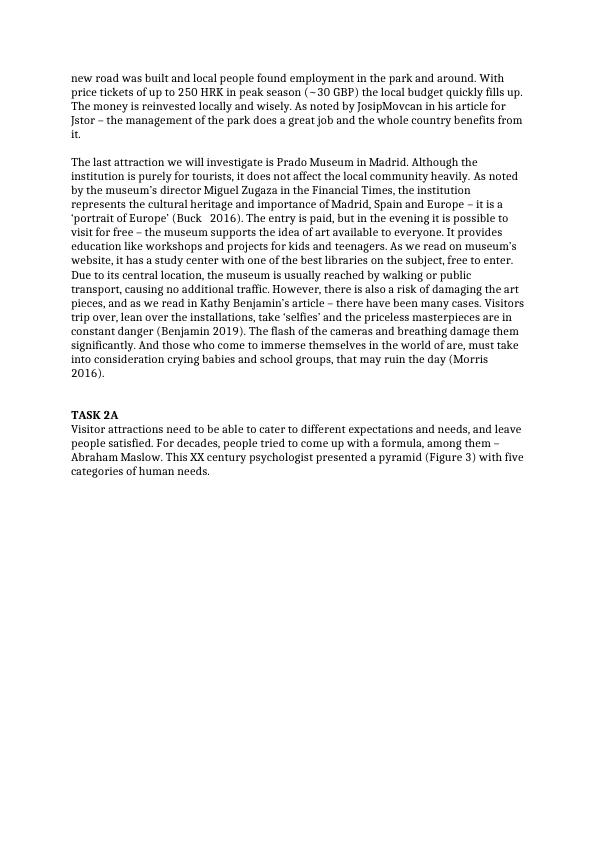Visitor Attractions and Their Impact on Local Communities
Added on 2023-04-08
16 Pages4976 Words268 Views
TASK 1A
A visitor attraction is a place of interest that draws the attention of a visitor due to the
natural or cultural value. It is a holistic concept of gaining aesthetic value from different
environmental factors. Visitor attractions are vital component of tourism industry.
Without them, there would no sense in visiting a destination. A site can be visited for
various reasons – natural beauty, historical importance or special event (Benjamin
2019). As we read in Tourism Management, the attractions can be categorized in
different ways, like built or natural, free or paid, public or private. Theybring a few other
classifications, but eventually agree that the one by English Tourism Council is the most
appropriate and common:
Cathedral and churches
Gardens
Country parks
Wildlife attractions and ZOOs
Leisure and theme parks
Farms
Historic houses and castles
Museums and galleries
Visitor centres
Other historic properties
Steam railways
Another classification is based on the environment of the attraction. Here the attractions
are categorized into those located in the:
Natural environment – mountains, forests, lakes;
Built environment adapted for tourism– castles, famous poets’ houses;
Built environment built for tourists – theme/amusement parks;
The events industry including conferences, exhibitions, shows, festivals, music events is
another for of attraction and a major draw to destinations in the low tourist season.
Yet some attractions may fall into more than one category, eg. Music festival located in a
fortress, like Exit Festival in Novi Sad, Serbia or concentration camps –definitely not
built for tourists, but, now visited by thousands. Some visitor attractions overlap into
various classifications, because they attract more tourists and diversity. Often, they fall
into one classification, but with time, it starts attracting other groups of visitors. An
example can be the Olympia Park in Munich (Buck 2016). Originally a sport venue to
host the 1972 Olympic Games, now the area of sport and recreation. The popularity of
Bayern Munich football club made it a mecca for football fans, as the site features the
team’s former stadium. The place is ideal for families with children, offering outdoor
activities for them as well as excellent shopping mall (Sandler et al. 2019). Another
example is Machu Picchu in Peru. The ancient Inca site originally attracted only those
interested in history or hiking. However the attraction evolved and now there are
multiple packages, like hiking trips, zip lining or rafting. Now, Machu Picchu attracts
much wider public. Last example is the castle in Ljubljana – originally an attraction for
history and architecture buffs, recently the castle opened up to wider public. Offering
outdoor cinema, interactive museums and ‘Escape Room’ the castle is now an interesting
A visitor attraction is a place of interest that draws the attention of a visitor due to the
natural or cultural value. It is a holistic concept of gaining aesthetic value from different
environmental factors. Visitor attractions are vital component of tourism industry.
Without them, there would no sense in visiting a destination. A site can be visited for
various reasons – natural beauty, historical importance or special event (Benjamin
2019). As we read in Tourism Management, the attractions can be categorized in
different ways, like built or natural, free or paid, public or private. Theybring a few other
classifications, but eventually agree that the one by English Tourism Council is the most
appropriate and common:
Cathedral and churches
Gardens
Country parks
Wildlife attractions and ZOOs
Leisure and theme parks
Farms
Historic houses and castles
Museums and galleries
Visitor centres
Other historic properties
Steam railways
Another classification is based on the environment of the attraction. Here the attractions
are categorized into those located in the:
Natural environment – mountains, forests, lakes;
Built environment adapted for tourism– castles, famous poets’ houses;
Built environment built for tourists – theme/amusement parks;
The events industry including conferences, exhibitions, shows, festivals, music events is
another for of attraction and a major draw to destinations in the low tourist season.
Yet some attractions may fall into more than one category, eg. Music festival located in a
fortress, like Exit Festival in Novi Sad, Serbia or concentration camps –definitely not
built for tourists, but, now visited by thousands. Some visitor attractions overlap into
various classifications, because they attract more tourists and diversity. Often, they fall
into one classification, but with time, it starts attracting other groups of visitors. An
example can be the Olympia Park in Munich (Buck 2016). Originally a sport venue to
host the 1972 Olympic Games, now the area of sport and recreation. The popularity of
Bayern Munich football club made it a mecca for football fans, as the site features the
team’s former stadium. The place is ideal for families with children, offering outdoor
activities for them as well as excellent shopping mall (Sandler et al. 2019). Another
example is Machu Picchu in Peru. The ancient Inca site originally attracted only those
interested in history or hiking. However the attraction evolved and now there are
multiple packages, like hiking trips, zip lining or rafting. Now, Machu Picchu attracts
much wider public. Last example is the castle in Ljubljana – originally an attraction for
history and architecture buffs, recently the castle opened up to wider public. Offering
outdoor cinema, interactive museums and ‘Escape Room’ the castle is now an interesting

way to spend a day for all types of visitors (Ljubljanskigrad.si 2019). To conclude, the
reason of overlapping of visitor attractions is the growing diversity of visitors. In the
past, it was a strict circle of travellers, visiting an attraction solely because of their
passion. Nowadays, due to a higher standard of life, higher income and easiness of travel,
there are different types of tourists, and the attractions need to adapt to them in order to
remain attractive. However, it is difficult to classify an attraction as visitor attraction is
based on the perception of the tourists visiting the place. For an example, a person who
has no belief on the existence of God would perceive a church to be of architectural
beauty, whereas a believer will associate the holistic value of the place with the peace
gained from the same. Therefore, differences in perceptions create an ambiguous
situation for the better understanding of significance of the attraction while classifying
the same.
TASK 1B
Visitor attractions affect local communities. Some of the impacts are positive, like
stimulating the economy, lowering unemployment or generating income. Unfortunately
there are also many negative effects. We are going to analyze a few attractions and their
impact on local area (Mint.gov.hr 2018).
First we will take a look at the Leaning Tower of Pisa. As illustrated by Figure 1, in 2016,
the town came second in Tuscany with over million visitors.
Figure 1: Number of international tourists arrivals in Tuscany (in thousands)
(Source: Statista 2017)
Those tourists usually visit Pisa on a day trip and then move on to other towns in
reason of overlapping of visitor attractions is the growing diversity of visitors. In the
past, it was a strict circle of travellers, visiting an attraction solely because of their
passion. Nowadays, due to a higher standard of life, higher income and easiness of travel,
there are different types of tourists, and the attractions need to adapt to them in order to
remain attractive. However, it is difficult to classify an attraction as visitor attraction is
based on the perception of the tourists visiting the place. For an example, a person who
has no belief on the existence of God would perceive a church to be of architectural
beauty, whereas a believer will associate the holistic value of the place with the peace
gained from the same. Therefore, differences in perceptions create an ambiguous
situation for the better understanding of significance of the attraction while classifying
the same.
TASK 1B
Visitor attractions affect local communities. Some of the impacts are positive, like
stimulating the economy, lowering unemployment or generating income. Unfortunately
there are also many negative effects. We are going to analyze a few attractions and their
impact on local area (Mint.gov.hr 2018).
First we will take a look at the Leaning Tower of Pisa. As illustrated by Figure 1, in 2016,
the town came second in Tuscany with over million visitors.
Figure 1: Number of international tourists arrivals in Tuscany (in thousands)
(Source: Statista 2017)
Those tourists usually visit Pisa on a day trip and then move on to other towns in

Tuscany. This way the whole region benefits from the popularity of the tower. As we
read in WeChianti, Tuscany – the region with less than 4 million residents, received 100
million tourists in 2017 (Movcan 1982). Thanks to the tower, people have jobs - local
cafes, bakeries and restaurants are busy and people earn money. WeChianti assures, that
the high numbers of visitors saved Tuscany from the economical crisis. The local
government receives a substantial income in a form of tourist taxes. This money is
converted in new roads, schools or hospitals (Pesa 2017). However, no one asked the
locals if they wanted those crowds in their town. There is no privacy for those living on
the way from the bus park to the Leaning Tower (Museodelprado.es 2019). The tourists
damage the infrastructure and litter. The coaches block the roads. The popularity of the
site also increased an illegal activity – street vendors, who sell the souvenirs without
permission and often pickpocket the tourists, leaving a bad last impression (Page
2014).
Another attraction is Plitvice Lakes National Park in Croatia. As illustrated by Figure 2,
the park received over 1.7 million visitors in 2017. The income that is generated from
the tourism activities in the area was €9.5 billion. The increasing rate of visitors in the
area helped in enhancing the rate of sustainability options in Plitvice Lakes National
Park.
Figure 2: Number of visitors in national parks in Croatia
( Source: Patrac 2017)
The reserve is of outstanding beauty featuring lakes in all shades of blue and green.
Unfortunately, the crowds may ruin the most amazing day in the park, because the
queues to buy tickets can be up to two hours (Patrac 2017). The wooden paths around
the lakes are damaged by never ending flow of tourists and frequently some of them are
closed. Occasionally there is someone attempting to swim. The animals hide away and
the plants are damaged. Tens of buses bring tourists into the park every day, increasing
the pollution levels. The situation became critical and led to protests, as we read in Petra
BoićPetrač’s article for WWF. However, the Croatian government does not lower the
number of visitors. The park benefits local community, such as in late 1990s, when the
park became the government’s priority to rid of war mines after the Yugoslavia War. A
read in WeChianti, Tuscany – the region with less than 4 million residents, received 100
million tourists in 2017 (Movcan 1982). Thanks to the tower, people have jobs - local
cafes, bakeries and restaurants are busy and people earn money. WeChianti assures, that
the high numbers of visitors saved Tuscany from the economical crisis. The local
government receives a substantial income in a form of tourist taxes. This money is
converted in new roads, schools or hospitals (Pesa 2017). However, no one asked the
locals if they wanted those crowds in their town. There is no privacy for those living on
the way from the bus park to the Leaning Tower (Museodelprado.es 2019). The tourists
damage the infrastructure and litter. The coaches block the roads. The popularity of the
site also increased an illegal activity – street vendors, who sell the souvenirs without
permission and often pickpocket the tourists, leaving a bad last impression (Page
2014).
Another attraction is Plitvice Lakes National Park in Croatia. As illustrated by Figure 2,
the park received over 1.7 million visitors in 2017. The income that is generated from
the tourism activities in the area was €9.5 billion. The increasing rate of visitors in the
area helped in enhancing the rate of sustainability options in Plitvice Lakes National
Park.
Figure 2: Number of visitors in national parks in Croatia
( Source: Patrac 2017)
The reserve is of outstanding beauty featuring lakes in all shades of blue and green.
Unfortunately, the crowds may ruin the most amazing day in the park, because the
queues to buy tickets can be up to two hours (Patrac 2017). The wooden paths around
the lakes are damaged by never ending flow of tourists and frequently some of them are
closed. Occasionally there is someone attempting to swim. The animals hide away and
the plants are damaged. Tens of buses bring tourists into the park every day, increasing
the pollution levels. The situation became critical and led to protests, as we read in Petra
BoićPetrač’s article for WWF. However, the Croatian government does not lower the
number of visitors. The park benefits local community, such as in late 1990s, when the
park became the government’s priority to rid of war mines after the Yugoslavia War. A

new road was built and local people found employment in the park and around. With
price tickets of up to 250 HRK in peak season (~30 GBP) the local budget quickly fills up.
The money is reinvested locally and wisely. As noted by JosipMovcan in his article for
Jstor – the management of the park does a great job and the whole country benefits from
it.
The last attraction we will investigate is Prado Museum in Madrid. Although the
institution is purely for tourists, it does not affect the local community heavily. As noted
by the museum’s director Miguel Zugaza in the Financial Times, the institution
represents the cultural heritage and importance of Madrid, Spain and Europe – it is a
‘portrait of Europe’ (Buck 2016). The entry is paid, but in the evening it is possible to
visit for free – the museum supports the idea of art available to everyone. It provides
education like workshops and projects for kids and teenagers. As we read on museum’s
website, it has a study center with one of the best libraries on the subject, free to enter.
Due to its central location, the museum is usually reached by walking or public
transport, causing no additional traffic. However, there is also a risk of damaging the art
pieces, and as we read in Kathy Benjamin’s article – there have been many cases. Visitors
trip over, lean over the installations, take ‘selfies’ and the priceless masterpieces are in
constant danger (Benjamin 2019). The flash of the cameras and breathing damage them
significantly. And those who come to immerse themselves in the world of are, must take
into consideration crying babies and school groups, that may ruin the day (Morris
2016).
TASK 2A
Visitor attractions need to be able to cater to different expectations and needs, and leave
people satisfied. For decades, people tried to come up with a formula, among them –
Abraham Maslow. This XX century psychologist presented a pyramid (Figure 3) with five
categories of human needs.
price tickets of up to 250 HRK in peak season (~30 GBP) the local budget quickly fills up.
The money is reinvested locally and wisely. As noted by JosipMovcan in his article for
Jstor – the management of the park does a great job and the whole country benefits from
it.
The last attraction we will investigate is Prado Museum in Madrid. Although the
institution is purely for tourists, it does not affect the local community heavily. As noted
by the museum’s director Miguel Zugaza in the Financial Times, the institution
represents the cultural heritage and importance of Madrid, Spain and Europe – it is a
‘portrait of Europe’ (Buck 2016). The entry is paid, but in the evening it is possible to
visit for free – the museum supports the idea of art available to everyone. It provides
education like workshops and projects for kids and teenagers. As we read on museum’s
website, it has a study center with one of the best libraries on the subject, free to enter.
Due to its central location, the museum is usually reached by walking or public
transport, causing no additional traffic. However, there is also a risk of damaging the art
pieces, and as we read in Kathy Benjamin’s article – there have been many cases. Visitors
trip over, lean over the installations, take ‘selfies’ and the priceless masterpieces are in
constant danger (Benjamin 2019). The flash of the cameras and breathing damage them
significantly. And those who come to immerse themselves in the world of are, must take
into consideration crying babies and school groups, that may ruin the day (Morris
2016).
TASK 2A
Visitor attractions need to be able to cater to different expectations and needs, and leave
people satisfied. For decades, people tried to come up with a formula, among them –
Abraham Maslow. This XX century psychologist presented a pyramid (Figure 3) with five
categories of human needs.

End of preview
Want to access all the pages? Upload your documents or become a member.
Related Documents
Visitor Attraction Managementlg...
|8
|2069
|30
Management of visitor attractionlg...
|7
|1536
|436
Visitors Attraction Management Assignment (Doc)lg...
|17
|6198
|379
Visitor Attraction Managementlg...
|12
|3859
|54
Visitor Attraction Management: TASK 3lg...
|21
|825
|320
Essay using academic literature and examples explain the role of museums and cultural attractions for touristslg...
|7
|1885
|23
